While writing a brief post for the CCA today about 19th-century "portable buildings" and their unexpected role in facilitating the European colonial project, I stumbled on the "portable camps" of Canadian shelter firm Weatherhaven. 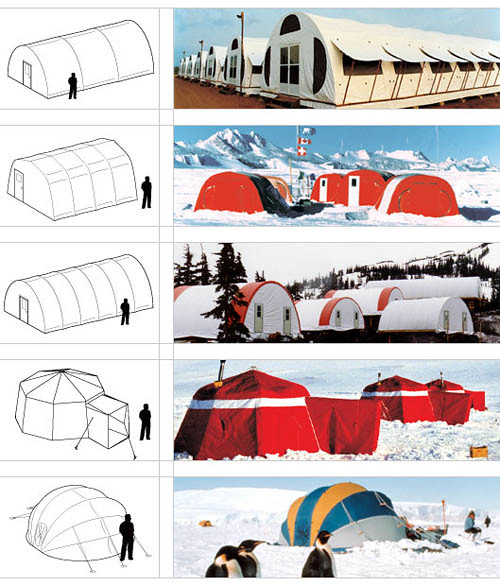 [Images: Multiple projects by Weatherhaven].
[Images: Multiple projects by Weatherhaven].
Weatherhaven was founded, historian Robert Kronenburg explains in his book Portable Architecture, "in 1981 by the merging of two separate businesses, an expedition organizing team and a Vancouver-based construction company."
- The founders recognized the need for a dedicated approach to the provision of temporary shelter in remote places and developed a strategy to provide a complete service including design, manufacture, packaging, transportation, and erection of buildings, all of which would be created specifically to respond to the logistical problems of remote deployment in harsh environments.
It is Flatpak City: pop open the box and go.
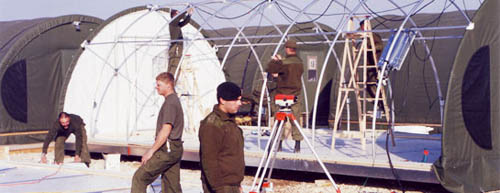 [Image: Service-installation by Weatherhaven].
[Image: Service-installation by Weatherhaven]."The first stage of the operation," Kronenburg writes, referring to a specific example of their cities-on-demand, "was to establish a Weatherhaven crew shelter so that a construction team could prepare a temporary landing site for heavier aircraft." From that initial seed, a whole civilization-by-airfield could be grown—an instant city from the sky. "A single crate was flown in by light aircraft and the building was assembled and in use within four hours."
- The team then prepared the camp layout, and as the rest of the building components and other equipment were flown in, assembled the entire facility... The completed facility included sleeping and leisure accommodation, a 24 hour kitchen, showers, and toilets, a hospital, offices, and an engineering base, and was built in 20 working days.
It is just-in-time urbanism: parachuting in whole cities and logistical systems till a new, geographically remote metropolis is up and running in less than three weeks.
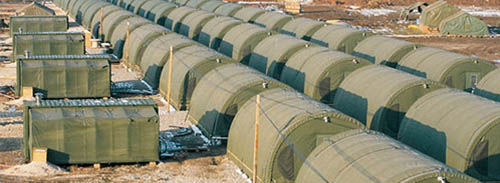 [Image: A military village by Weatherhaven].
[Image: A military village by Weatherhaven].These temporary mining villages and other extraction towns—somewhere above the Arctic Circle or deep in the desert, "often so remote as to be invisible to most of the world"—unfold in an industrial nanosecond. They stick around for mere years and then disappear, leaving no real archaeological traces, producing no tourist postcards, finding no place on any map, perhaps never even achieving the status of a formal name, yet nonetheless managing to house thousands of workers at a time.
What role should such compounds play in the writing of urban and architectural history?
 [Image: A military village by Weatherhaven].
[Image: A military village by Weatherhaven].At the very least, these "longer-stay remote shelters," as Kronenburg calls them, are surely as vital to the global economy—with deep connections to the extraction industries, from diamond mines to tar sands—as the banking district of a recognized urban conglomerate. How ironic it would be to discover someday that an instant village for 2,000 residents, air-delivered by Weatherhaven into the emotionally bleak but mineralogically rich Australian Outback, has a larger economic footprint than the entire business district of a city like Sydney.
In many ways, I'm reminded of an article published last week in which we read that "Cisco Systems is helping build a prototype in South Korea for what one developer describes as an instant 'city in a box'."
- Delegations of Chinese government officials looking to purchase their own cities of the future are descending on New Songdo City, a soon-to-be-completed metropolis about the size of downtown Boston that serves as a showroom model for what is expected to be the first of many assembly-line cities.
Cities will be things you have delivered to you, like pizza, and they and their residents will be treated just as disposably.
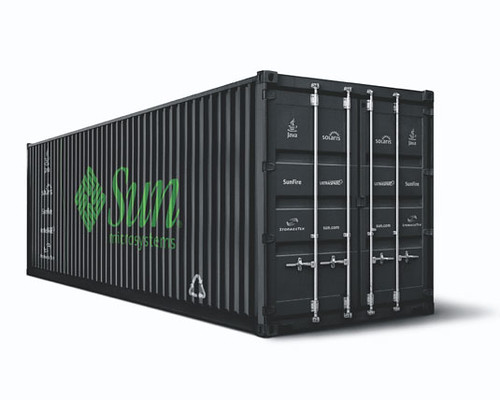
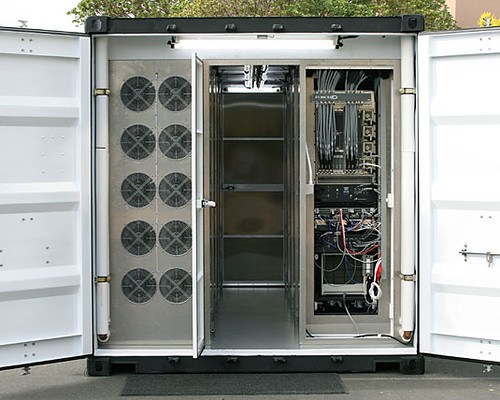 [Image: The "modular datacenter" of Sun's Project Blackbox, a stackable, shipping container-based, portable supercomputing and data storage unit].
[Image: The "modular datacenter" of Sun's Project Blackbox, a stackable, shipping container-based, portable supercomputing and data storage unit].Offloading a few of Sun's Project Blackbox units, seen above, in order to construct a privately chartered city-in-a-box, based around a remote airfield somewhere in the Canadian Arctic, is something as likely to be seen in a Roger Moore-era James Bond film as it is in the corporate spreadsheets of a firm like Rio Tinto; but I'm left dwelling on the question of where these sorts of settlements belong in architectural history.
Purpose-built instant cities "purchased" wholesale from private suppliers, and erected in as little as one month's time, are only going to increase in quantity, population, diversity of purpose, and global economic importance in the decades to come; their impact on political science and concepts of sovereign territory and constitutional law is something we can barely even begin to anticipate. But if architects have more to learn from the international warehousing strategies of Bechtel than they do from the Farnsworth House or the software packages of Patrik Schumacher, then what role might firms like Weatherhaven prove to have played in transforming how we understand the built environment?
Put another way, should the COO of Weatherhaven be invited to contribute to Icon's next "Manifesto" issue? If so, what might architects and urban planners learn?
(Thanks to my dad for the Cisco "city-in-a-box" link!)